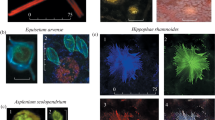Summary
There are many Sphagna which show a remarkable variation in colour within a vegetation period.
The red colour is caused by wall pigments which were believed till now to be anthocyanins (Paul 1908; Herzfelder 1921; Goodman u. Paton 1954; Paton u. Goodman 1955; Rothe 1963). The pigmentation is due to metabolic disturbances and the conditions of reddening are already analyzed under definite conditions (Rudolph 1965).
There are great difficulties in extraction of the pigments. We have described a method by which the pigments can be extracted from fresh sphagnun material (see also Rudolph 1963a). The pigments are separated by column chromatography and at first we have tried to characterize the violett-red Kardinalpigment of Sphagnum magellanicum (A2 mag) and Sphagnum rubellum (A2 rub) by Rfvalues, spray-reagents and the absorption spectra; therefore always chromatographically pure pigments are used.
The pigments are different from known anthocyanins and seem to be aglyca.
Zusammenfassung
Es ist gelungen, zwei bisher sehr schwer zugängliche Wandfarbstoffe aus S. mag. und S. rub. chromatographisch rein darzustellen. Auf Grund des papierchromatographischen Verhaltens, der Reaktionen auf Sprühreagentien und der Lage der Absorptionsmaxima ergibt sich, daß die Verbindungen nicht mit einem bekannten Anthocyan identifizierbar sind, so daß man besser zunächst bei den Wandfarbstoffen der Torfmoose mit der Bezeichnung Wandanthocyan sehr vorsichtig sein sollte. Die Verbindungen sind wahrscheinlich Aglyca. Ihre weitere Analyse ist im Gange.
Similar content being viewed by others
Literatur
Bendz, G., O. Mårtensson, and L. Terenius: Moss pigments. I. The anthocyanins of Bryum cryophilum O. Mårt. Acta chem. scand. 16, 1183–1190 (1962).
Goodman, P. J., and J. A. Paton: Anthocyanin in Sphagnum. Trans. Brit. Bryolog. Soc. 2, Part 3, 740 (1954).
Grisebach, H.: Die Biosynthese der Anthocyane. Vorabdruck Nr 7, IV. Internat. Kongr. f. Biochemie, Wien 1958.
—: The biosynthesis of isoflavones. Recent developments in the chemistry of natural phenolic compounds, Chap. 3, p. 59–73. Oxford, London, New York, Paris: Pergamon Press 1961.
—, and W. D. Ollis: Biogenetic relationships between coumarins, flavonoids, isoflavonoids, and rotenoids. Experientia (Basel) 17, 4–12 (1961).
Herzfelder, H.: Beiträge zur Frage der Moosfärbungen. Beih. bot. Zbl. 38, 355–400 (1921).
Nagai, Isaburo: Über roten Pigmentbildung bei einigen Marchantia. Arten. Bot. Mag. 29, No 337-348, 90–98 (1915).
Paton, J. A., and P. J. Goodman: The conditions promoting anthocyanin-formation in Sphagnum nemoreum Scop. trans. Brit. Bryolog. Soc. 2, Part 4, 561–567 (1955).
Paul, H.: Die Kalkfeindlichkeit der Sphagna und ihre Ursache nebst einem Anhang über die Aufnahmefähigkeit der Torfmoose für Wasser. Mitt. K. Bayr. Moorkulturanst. H. 2 (1908).
Reznik, H.: Untersuchungen über die physiologische Bedeutung der chymochromen Farbstoffe. S.-B. Heidelb. Akad. Wiss. 125–217 (1956).
—: Über den physiologischen Zusammenhang der Lignin- und Flavonoid-Bildung. Proc. 4th Int. Congr. Biochem. Vienna, Vol. 2, p. 70 (1959) London.
—: Vergleichende Biochemie der Phenylpropane. Ergebn. Biol. 23, 14–46 (1960).
Rothe, E.: Beiträge zur Kenntnis der Färbungen und Farbstoffe bei Torfmoosen (Sphagnum). Beitr. Biol. Pflanzen 38, 331–381 (1963).
Rudolph, H.: Die Kultur von Hochmoorsphagnen unter definierten Bedingungen. Beitr. Biol. Pflanzen 39, 153–177 (1963).
—: Präparative Darstellung eines roten Wandfarbstoffes von Sphagnum magellanicum. Ber. dtsch. bot. Ges. 76, 72–73 (1963a).
—: Die Kultur der Sphagnen unter definierten Bedingungen als Weg zur Klärung physiologischer und ökologicher Probleme im Hochmoor. Ber. dtsch. bot. Ges. 76, 16–20 (1963b).
Rudolph, H.: Zur Frage der Membranochromie bei Sphagnen. I. Welche Faktoren bestimmen den Farbwechsel. Flora (Jena) 155, (1965).
Schmidt, H.: Biosynthese phenolischer Pflanzeninhaltsstoffe. Pharmazie 18, 445–456 (1963).
Schou, S. A.: Über die Lichtabsorption einiger Anthocyanidine. Helv. chim. Acta 10, 907–915 (1927).
Schwerdtfeger, E.: Modifizierte eindimensionale Papierchromatographie für quantitative Zwecke. Naturwissenschaften 41, 18 (1954).
Seybold, A.: Pflanzenpigmente und Lichtfeld als physiologisches, geographisches und landwirtschaftlich-forstliches Problem. Ber. dtsch. bot. Ges. 60, 64–85 (1942).
Author information
Authors and Affiliations
Additional information
Mit 1 Textabbildung
Rights and permissions
About this article
Cite this article
Rudolph, H. Zur Frage der Membranochromie bei Sphagnen. Planta 64, 178–185 (1965). https://doi.org/10.1007/BF00396010
Received:
Issue Date:
DOI: https://doi.org/10.1007/BF00396010




